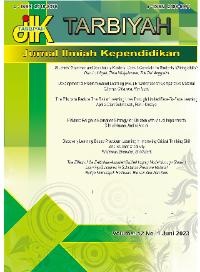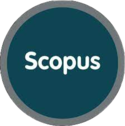The Development of Interactive Audio-Visual-Based Media Using VideoScribe to Reduce Misconceptions Electrical Potential and ECG Material
DOI:
https://doi.org/10.18592/tarbiyah.v12i2.10301Keywords:
audio visual, ECG, electrial potential, misconception, videoscribeAbstract
This research aimed to assess the suitability of the developed Audio-Visual Media and its effectiveness in reducing student misconceptions. The research follows the R&D (Research and Development) approach, specifically utilizing the ADDIE development model developed by Branch. The research participants comprised 17 9th-grade students from SMP Swasta Hang Tuah 2 Medan. The research procedures included a pre-survey, instrument creation, survey and observation, and validation. The results of the developed media showed that the first indicator, related to the response to material presentation, fell within the "good" category, with a percentage of 80.20%. The second indicator, which assessed the attractiveness of Sparkol VideoScribe's video display, was categorized as "very good," with the highest percentage recorded at 84.25%. Similarly, the response to convenience, representing the third indicator, was considered "good" with a percentage of 80.81%. The fourth indicator was also classified as "good," with a percentage of 79.40%. Based on the data analysis, the developed media is deemed feasible and can be utilized effectively in science learning.References
Bahrun, S. A., Fatmah, K. M., Wilujeng, I., Suyanta., & Rejeki, S. (2023). The Use of Videoscribe Animation-Based Science E-Modules on Science Literacy of Junior High School Students. JPPIPA: Jurnal Penelitian Pendidikan IPA, 9(6), 4718-4722.
Branch, R. M. (2009). Instructional Design-The ADDIE Approach. New York: Springer.
Didik, L. A., & Aulia, F. (2019). Analisa Tingkat Pemahaman Dan Miskonsepsi Pada Materi Listrik Statis Mahasiswa Tadris Fisika Menggunakan Metode 3-Tier Multiple Choices Diagnostic. Jurnal Phenomenon, 9(1), 99-112.
Febrianto, A., & Shalikhah, N. D. (2020). Modul Membuat Media Pembelajaran Dengan VideoScribe Versi 3.2.1. Yogyakarta: UNY Press.
Fitria, S. E., & Ariva, V. F. (2018). Analisis Faktor Kondisi Ekonomi Tingkat Pendidikan dan Kemampuan Berwirausaha Terhadap Kinerja Usaha Bagi Pengusaha Pindangan di Desa Cukanggenteng. Jurnal Manajemen Indonesia, 18(3), 197-208.
Halim, A., Mahzum, E., Zanaton., & Humairah, H. (2020). Impact of EduPlasa Interactive Media on Reducing Misconceptions of Static Fluid in High School Students. Journal of Physics: Conference Series, 1521, 1-9.
Heny, S. D. N. K., Suwindra, I. N. P., & Mardana. (2018). Strategi Pemblajaran Guru: Relevansinya Dalam Mereduksi Miskonsepsi dan Peningkatan Prestasi Belajar Siswa. JPPF, 8(1), 1-10.
Imamah, N., Ma’ruf, A. (2018). Pengaruh Penerapan Media Videoscribe Untuk Meningkatkan Pemahaman Aqidah Akhlaq di MTS Darul Ulum Purwodadi. Jurnal Pendidikan Islam. 4(1), 87-102.
Indayani, R., Supeno., & Wicaksono, I. (2021). Pengaruh Videoscribe Terhadap Keterampilan Berpikir Kritis Peserta Didik Pada Pembelajaran IPA. Edu Sains: Jurnal Pendidikan Sains dan Matematika, 9(2), 107-115.
Inggit, S. M., Liliawati, W., & Suryana, I. (2021). Identifikasi Miskonsepsi dan Penyebabnya Menggunakan Instrumen Five-Tier Fluid Static Test (5TFST) pada Peserta Didik Kelas XI Sekolah Menengah Atas. Journal of Teaching and Learning Physics, 6(1), 49-68.
Iqbal, M., Samsudin, A., & Efendi, R. (2020). Penggunaan Adaptasi Instrumen Epepect Untuk Membedakan Siswa Yang Mengalami Miskonsepsi Dan Mengetahui Tingkat Miskonsepsi Siswa MA Kelas XII Pada Konsep Medan Listrik, Potensial Listrik Dan Energi Potensial Listrik. Jurnal Luminious: Riset Ilmiah Pendidikan Fisika, 1(1), 51-59.
Jannah, Miftachul. 2019. Aplikasi Media Pembelajaran Fisika Berbasis Sparkol Videoscribe Pada Pokok Bahasan Suhu Dan Kalor Terhadap Hasil Belajar Siswa SMK. Jurnal Ilmiah Mahasiswa Fisika, 3(2), 66-71.
Jannah, N. N., Anditya, N., Liliawati, W., & Muslim. Identification of Physical Misconceptions and Their Causes Using Five-Tier Kinematics Test (FTKT) on High School Students. JoTaLP: Journal of Teaching and Learning Physics, 7(1), 42-53.
Johnson, A., & Smith, B. (2018). Fostering Conceptual Change through Cognitive Conflict. Journal of Science Education and Technology, 27(2), 162-175.
Manurung, G. A., Simanjuntak, L.A., & Sihombing, R. A. (2021). Misconceptions on The Concept of Photosythesis and Plant Respiration For Class VIII at SMP Negeri 27 Medan in Science Learning. Indonesian Science Education Research (ISER), 3(2), 12-19.
Manzilina, F., Listiawati, E., & Wijayanti, R. (2020). Pengembangan Media Videoscribe Pada Materi Sistem Persamaan Linier Dua Variabel (SPLDV). Jurnal Ilmiah Pendidikan Matematika, 5(2), 185-199.
Nasrudin, H., & Azizah, U. (2020). Overcoming Students Misconception through Implementation of Metacognitive Skills-Based Instructional Materials in Energetics. Jurnal Pendidikan IPA Indonesia, 9(1), 125-134.
Octavia, S. C., Sihombing, R.A., Destine, K. T., & Hutagalung, J. F. (2022). Analysis of Obstacles on Limited Face-To-Face Learning During the Covid-19 Pandemic Junior High School in Medan. Tarbiyah: Jurnal Ilmiah Kependidikan, 11(1), 18-28.
Panggabean, F. T. M., Simanjuntak, L. A., Sihombing, R. A., Octavia, S. C., Tambunan, J. B. (2023). Analysis of 7th-Grade Students' Misconceptions of Acid-Base. J-PEK (Jurnal Pembelajaran Kimia), 8(1), 1-7.
Pranata, I. M. A. A., & Jayanta, I. N. L. (2021). Improving Students' Comprehension About Energy Sources Through Sparkol Videoscribe-Based Learning Media. Jurnal Ilmiah Sekolah Dasar, 5(2), 212-221.
Putri, L. O. L., Rahman, T., Priyandoko, D. (2017). Analyzing Concepts Mastery and Misconceptions About Evolution of Biology Major Students. IOP Conf. Series: Journal of Physics: Conf. Series, 812, 1-6.
Rahayu, D. Y., Siswandari., & Sudarno. (2022). The Effectiveness of Videoscribe Media to Increase Student Learning Activity. International Journal of Innovation, Creativity and Change, 16(1), 21-33.
Salamah, U. (2020). Upaya Memperbaiki Miskonsepsi dan Hasil Belajar Siswa Kelas XI-IPA 1 SMAN 2 Bau-Bau Melalui Penerapan Model Pembelajaran Ici (Interactive Conceptual Instruction) Berbantuan LKS Berbasis Lingkungan. Indonesian Journal of Educational Research and Review, 3(1), 1-10.
Saptono, B., Herwin, H., & Dahalan, S. C. (2023). VideoScribe’s Sparkol-Based Learning to Improve Learning Outcomes: A Classroom Action Research. International Journal of Information and Education Technology, 13(4), 749-756.
Sihombing, R. A., Manurung, G. A., & Simanjuntak, L. A. (2022). Analysis Implementation of Technological Pedagogical Content Knowledge by Science Teachers Through Distance Learning at Junior High School In Medan. Jurnal Pendidikan Matematika dan IPA, 13(2), 214-230.
Silfiani., Jasruddin., Amin, B. D. (2022). Development of VideoScribe Assisted Learning Media to Improve Understanding of Physics Concepts. JPPIPA: Jurnal Penelitian Pendidikan IPA, 8(6), 2995-3000.
Silviani, R., Muliyani, R., & Kurniawan, Y. (2020). Application of Three-Tier Test for Identification of Misconception Student Quantity on Magnetic Pole. International Journal of Multi Discipline Science (IJ-MDS), 3(1), 22-25.
Simatupang, H., Siregar, E. H., Sihombing, R. A., & Tanjung, M. Y. (2023). Profile of Technology Pedagogical Content Knowledge-21 (TPACK21) on Pre-Service Science Teacher in Microteaching Course. Sciendo, 2022, 764-771.
Soeharto, S., Csapó, B., Sarimanah, E., Dewi, F. I., & Sabri, T. (2019). A Review Of Students’ Common Misconceptions in Science and Their Diagnostic Assessment Tools. Jurnal Pendidikan IPA Indonesia, 8(2), 247-266.
Sugiyono. (2017). Metode Penelitian Kuantitatif, Kualitatif, dan R&D. Bandung: CV. Alfabeta.
Trisnawati, A., Erniwati., Eso, R., & Mustari. (2020). Analisis Miskonsepsi Terhadap Materi Rangkaian Listrik Searah (DC) pada Siswa SMK Negeri Kota Kendari Menggunakan Four-Tier Diagnostic Test. Jurnal Penelitian Pendidikan Fisika, 5(4), 287-294.
Widyawati, E., Jatmiko, B., & Widodo, W. (2019). Learning Development of Cooperative Model Based PhET Media to Reduce Potential Misconceptions in Dynamic Electric Matter for Tenth Grade in State Senior High School. International Journal of Innovative Science and Research Technology, 4(1), 546-557.
Yolviansyah, F., Siregar, J., & Maison. (2022). The Relationship of Critical Thinking Skills and Misconceptions on Science Learning. Thinking Skills and Creativity Journal, 5(2), 52-61.
Young, J. C., Rose, D. C., Mumby, H. S., Capistros, F. B., Derrick, C. J., Finch, T., Garcia, C., Home, C., Marwaha, E., Morgans, C., Parkinson, S., Shah, J., Wilson, K. A., Mukherjee, N. (2017). A Methodological Guide to Using and Reporting on Interviews in Conservation Science Research. Methods in Ecology and Evolution, 9(1), 10-19.
Downloads
Published
How to Cite
Issue
Section
License
Copyright (c) 2023 Rizky Agassy Sihombing, Muslim, Taufik Rahman

This work is licensed under a Creative Commons Attribution 4.0 International License.
Authors retain copyright and grant the journal right of first publication with the work simultaneously licensed under a Creative Commons Attribution 4.0 International License that allows others to share the work with an acknowledgment of the work's authorship and initial publication in this journal.




